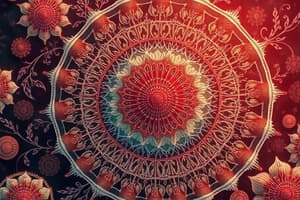Podcast
Questions and Answers
Which organelle is responsible for the production of energy in a cell?
Which organelle is responsible for the production of energy in a cell?
- Ribosomes
- Mitochondria (correct)
- Vacuole
- Nucleus
What is the function of chloroplasts in plant cells?
What is the function of chloroplasts in plant cells?
- Protein synthesis
- Photosynthesis (correct)
- Energy production
- Waste removal
In which part of the human digestive system does the digestion of starch to glucose mainly occur?
In which part of the human digestive system does the digestion of starch to glucose mainly occur?
- Large intestine
- Small intestine (correct)
- Stomach
- Mouth
What is the main function of the cell membrane?
What is the main function of the cell membrane?
What is a key role of enzymes in metabolic reactions?
What is a key role of enzymes in metabolic reactions?
Which process involves the movement of water across a semi-permeable membrane?
Which process involves the movement of water across a semi-permeable membrane?
What is the final product of photosynthesis in plants?
What is the final product of photosynthesis in plants?
Carbohydrates are made up of which basic units?
Carbohydrates are made up of which basic units?
Peristalsis is primarily responsible for:
Peristalsis is primarily responsible for:
Explain the importance of cell differentiation in the development of specialised cells.
Explain the importance of cell differentiation in the development of specialised cells.
Describe the advantages and disadvantages of using stem cells in medicine.
Describe the advantages and disadvantages of using stem cells in medicine.
Identify the chemical elements present in carbohydrates, proteins, and lipids.
Identify the chemical elements present in carbohydrates, proteins, and lipids.
Describe the structure of carbohydrates, proteins, and lipids as large molecules made up from smaller basic units.
Describe the structure of carbohydrates, proteins, and lipids as large molecules made up from smaller basic units.
Explain how temperature changes can affect enzyme function, including changes to the shape of the active site.
Explain how temperature changes can affect enzyme function, including changes to the shape of the active site.
Describe the processes of diffusion, osmosis, and active transport in moving substances into and out of cells.
Describe the processes of diffusion, osmosis, and active transport in moving substances into and out of cells.
Explain the process of photosynthesis and its importance in converting light energy to chemical energy.
Explain the process of photosynthesis and its importance in converting light energy to chemical energy.
Describe the structure of the leaf and explain how it is adapted for photosynthesis.
Describe the structure of the leaf and explain how it is adapted for photosynthesis.
Understand the role of digestive enzymes, including the digestion of starch to glucose by amylase and maltase.
Understand the role of digestive enzymes, including the digestion of starch to glucose by amylase and maltase.
Describe the process of peristalsis and how it helps in moving food through the gut.
Describe the process of peristalsis and how it helps in moving food through the gut.
Flashcards are hidden until you start studying




